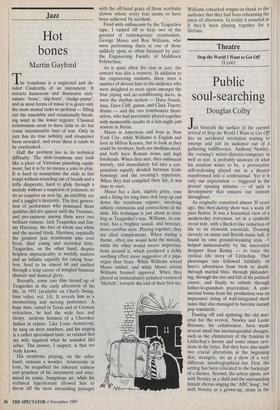Jazz
Hot bones
Martin Gayford
The trombone is a neglected and de- rided Cinderella of an instrument. It attracts humorous and dismissive nick- names: 'bone', 'slip-horn', 'sludge-pump', and in most forms of music it is given only the most menial tasks to perform — filling out the ensemble and occasionally break- ing wind in the lower register. Classical trombonists seem to have little to do but count interminable bars of rest. Only in jazz has its true nobility and eloquence been revealed, and even there it tends to be overlooked.
Half the problem lies in its technical difficulty. The slide-trombone may look like a piece of Victorian plumbing equip- ment, but it is by no means a joke to play. It is hard to manipulate the slide at fast tempi without sounding out of breath and a trifle desperate, hard to glide through a melody without a suspicion of jerkiness: to do so requires an iron lip, an infallible ear and a juggler's dexterity. The first genera- tion of performers who possessed those qualities did not appear until the Twenties, and pre-eminent among them were two brilliant virtuosi: Jack Teagarden and Jim- my Harrison, the first of whom was white and the second black. Harrison, reputedly the greatest jazz trombonist who ever lived, died young and recorded little. Teagarden, on the other hand, despite helpless impracticality in worldly matters and an infinite capacity for taking bour- bon, lived to be almost 60 and ambled through a long career of mingled financial disaster and musical glory.
Recently, some rare film turned up of Teagarden in the early afternoon of his life, in 1951 (available on Charly Swing- time video, vol. 14). It reveals him as a mesmerising and moving performer. A huge man, raised in Texas and of German extraction, he had the wide face and sleepy, sardonic features of a Cherokee Indian in repose. Like Louis Armstrong, he sang on most numbers, and his singing is a rather specialised taste; so relaxed that my wife inquired what he sounded like sober. The answer, I suspect, is that no- body knows.
His trombone playing, on the other hand, remains a wonder. Aristocratic in tone, he magnified the inherent sadness and grandeur of his instrument and mini- mised its comic, bumptious air, while his technical legerdemain allowed him to throw off the most astounding passages with the off-hand grace of those acrobatic clowns whose every feat seems to have been achieved by accident.
Fired with enthusiasm by the Teagarden tape, I rushed off to hear two of the greatest of contemporary trombonists, George Masso and Roy Williams, who were performing duets at one of those unlikely spots so often favoured by jazz: the Engineering Faculty of Middlesex Polytechnic.
As is quite often the case in jazz, the concert was also a reunion. In addition to the engineering students, there were a number of devout fans in the audience who were delighted to meet again amongst the blue piping and air-conditioning ducts, as were the rhythm section — Dave Green, bass, Dave Cliff, guitar, and Clark Tracey, drums — and the two trombonists them- selves, who had previously played together with memorable results at a late-night jam session in Berne.
Masso is American and lives in New York City, while Williams is English and lives in Milton Keynes, but to look at they could be brothers; both are medium-sized, and both have Roman noses and high foreheads. When they met, they embraced warmly, and immediately fell into a con- versation equally divided between trom- bonology and the evening's repertoire. When they had compiled their list, it was time to start.
Masso has a dark, slightly gritty, tone and a liking for long lines that loop up and down the trombone register, involving athletic extensions and contractions of the slide. His technique is just about as start- ling as Teagarden's was. Williams, in con- trast, has a brighter sound, and breezier, more carefree style. Playing together, they are ideal complements. When stating a theme, often one would hold the melody, while the other would weave improvisa- tions around' it, which produced a richly soothing effect more suggestive of a pipe- organ than brass. While Williams soloed Masso smiled, and while Masso soloed Williams beamed approval. When they played an immaculately polished version of `Skylark', towards the end of their first set, Williams remarked tongue-in-cheek to the audience that they had been rehearsing the piece all afternoon. In reality it sounded as if they'd been playing together for a lifetime.
















































 Previous page
Previous page